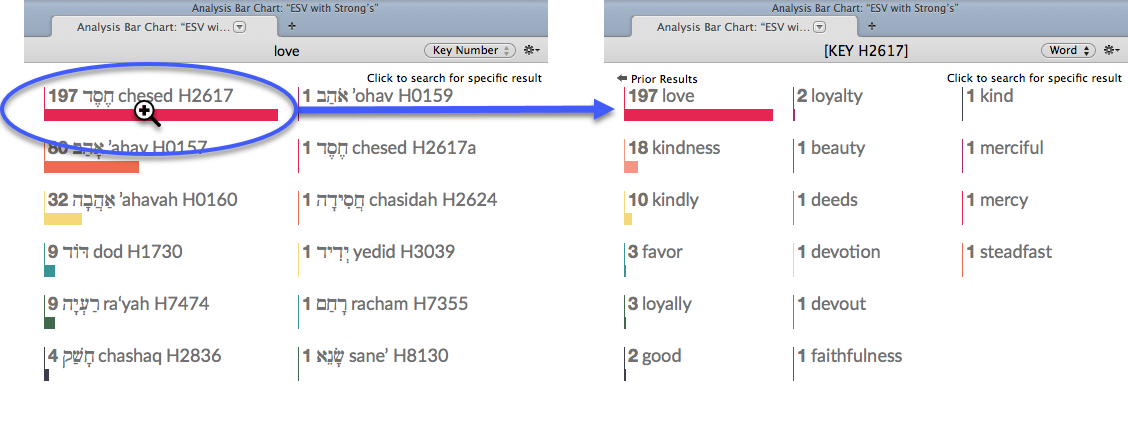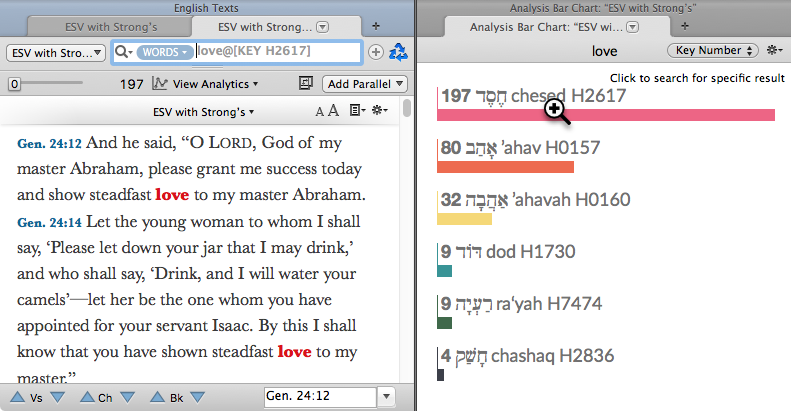Analysis Bar Chart
The Analysis Bar Chart is different from the Analysis Graph in three basic ways:
- It does not show the distribution across the search range.
- It displays the search results with the total number in each class as simple bars.
- It allows you to focus on individual hit results as you "drill down" through the items in the Analysis Bar Chart tab.
This example shows the results of searches for Love in the Old Testament (NASB, a Key Number Text), broken down by Key Number.

Understanding the Analysis Bar ChartUnderstanding the Analysis Bar Chart
- Each bar is labeled with its name and a number count.
- The text at the top of the Bar Chart tab displays the search argument.
- Class pop-up menu (upper right): Used to choose a different class to analyze.
- The Action menu (
 ) provides access to additional items.
) provides access to additional items. - Count options: The word total labels can be placed to the left or right of the word, or removed from the display.
- Count as Percentage: The word total labels are viewed as a percentage of the total.
- Use Black Background: The Pie Chart background is displayed as black, instead of white.
- Customize Display...: Opens the Set Analysis Bar Chart Display dialog box.
- Up to 128 bars can be displayed at once, in up to 4 columns.
- Click on a specific bar to perform the following analyses:
- Key Number text: Click a specific bar to display an analysis of the word.
- If the Analysis Bar Chart tab is displaying results by Key Number, clicking a specific bar displays the ways in which that original language word is translated in the original search text.
- If the Analysis Bar Chart tab is displaying results by Word, clicking a specific bar displays all the original language words that are translated by that form.
- Grammatically Tagged Original Language text: Click a specific bar to display an analysis of the specific word or grammatical form.
- Clicking a result in a Grammatically Tagged text displays the forms of the selected word, as specified in the Class pop-up menu.
This example shows the results of a search for Love in the Old Testament (in the ESV, an English Key Number Text). Clicking the chesed bar (a magnifying glass icon appears) in the Analysis Bar Chart tab displays the ways that the word is translated in the ESV. Click Prior Results (top left of the tab) to return to the original bar chart.

Shift-click an item in the Bar Chart tab to perform a search for that item. In this example, shift-clicking on chesed in the Analysis Bar Chart tab opens a new search tab, displaying the results of the search.

SettingsSettings
You can change the default display of the bar chart.
-
Right-click within the Bar Chart and choose Set Graph Display. The Set Analysis Bar Chart Display dialog box appears.
You can also use the Action pop-up menu (
 ) to access this and other items.
) to access this and other items. - Change the settings as desired. You can choose:
- the default analysis class.
- the position of the count label.
- black or white background.
- the color of each bar.